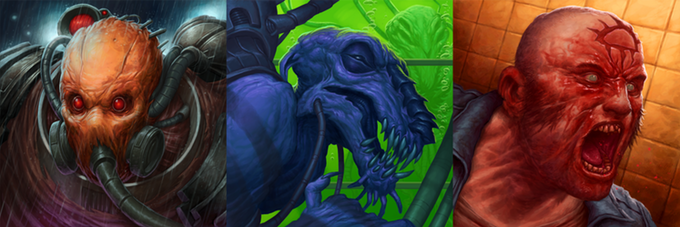The SLA Industries roleplaying game first appeared twenty-five years ago. As an entirely new setting, SLA (pronounced “Slay”) Industries was praised for its originality and iconic themes, for which it won numerous awards.
The game is based around a far-future dystopia. Much of the known universe is owned, or indirectly controlled, by the eponymous corporation SLA Industries. The game combined themes from the cyberpunk, gothic horror and conspiracy genres.
The World of Progress, the universe in which SLA Industries is set, is a retro-futuristic image from the 1980s; fax machines endlessly spew information alongside green-screen computers and vat-grown biogenetic monsters, whilst humans and exotic aliens compete for work in a vast overgrown city that plunges deep underground.
With the successful SLA Industries kickstarter recently finishing, Chris Shepperson took the time to discuss what makes The World of Progress come to life.
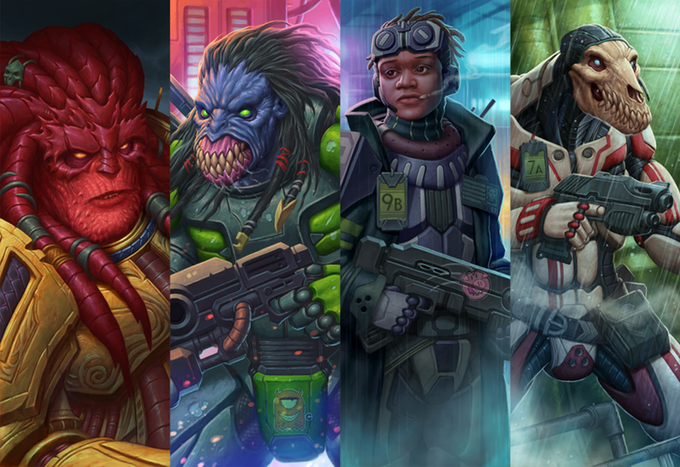
How do you describe SLA Industries to those who are unfamiliar with it?
Horror Noir is my go-to description, though most people stare at me blankly when I say that. I think it’s important to highlight the horror aspect to newcomers to the franchise though, as it’s pretty easy to be blinded by the powered armour, big aliens and even bigger guns.
It is a sci-fi game. It is a dystopian dark future, but it’s far from cyberpunk. The technology level is almost 80’s-like, with no internet and an abundance of fax machines, which makes it both interesting and tricky to describe.
It’s a bit of a cop-out, but an easy way to describe SLA Industries as Se7en meets Blade Runner (the original one, 2049 is a too high-tech); a dark psychological thriller meets biogenetic engineering in a huge mega-city.
What is your role in Nightfall?
We’re a pretty fluid organisation, as there are four of us and we’re all just ‘director’. We made up some job titles at one point, but other than Dave being the Art Director, we all just do what needs to be done. Predominantly, I’m a writer and the majority of my time not spent on social media or Kickstarter is spent writing. I’ve also become ‘the rules guy’, firstly by finalising the Cannival Sector 1 skirmish game when I came onboard, then finalising all the rules and stats for the RPG content in Cannibal Sector 1, then building the new 2nd Edition rules set from the ground up.
I enjoy rules and mechanics and have worked on a number of board games for publishers in the past, but it’s been great to have free rein on something much larger. I’m not all rules though, in fact I enjoy writing lore and fiction more than anything else.
Why have you chosen to release a new edition of SLA Industries?
For as long as Dave and Jared can recall, people have been asking for a new system. The old system was fairly forward thinking in 1993, but it was quite involved, especially the combat system. SLA was a game that was cursed by people who loved the setting to death, but struggled with the system, which led to a lot of home brew versions and unofficial conversions to World of Darkness and Savage Worlds etc. For a publisher, you obviously would like people to use the ’official’ version of your game and 2nd Ed was the perfect way to address that call from the fans.
At the same time, the game has been through many publishers over the years and the writing and production of content has moved between a few different teams. Ultimately this has led to some of the material out there being out of line with the original view of the game. Not bad by any standard, but not really how Dave saw the setting panning out over time.
With the intellectual property now back in the hands of Nightfall, and with myself and Mark Rapson on board, we wanted to move things along, both for the good of the game and for Nightfall as a company. A second edition was our chance to retcon a few bits that didn’t feel right, iron out contradictions between a few of the old books and laydown a refined canon for the future of the game. It has taken twenty-six years to do it, but the second edition core book will serve as the spring board for the future of the game.
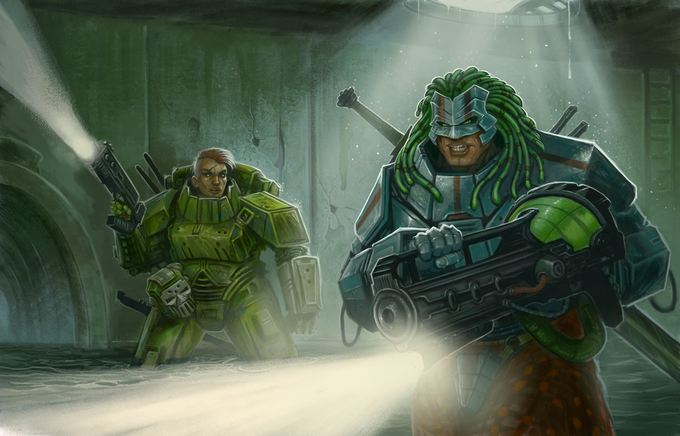
SLA Industries was ground-breaking at the time due to its themes and setting, how do you retain that freshness?
I think the themes are still fairly relevant. Firstly, many of the themes are very dark and ‘adult’ in nature, and cover aspects that other publishers don’t want to tread: human trafficking, drug abuse, serial killings and televised violence are all subjects that are rare in the gaming genre. We don’t really fear to step into these subjects, though we are far more mindful of their impact on gamers these days.
The original game came out of a post-Thatcher Glasgow in the 90’s, where the setting and politics in the game were an exaggeration of the time. The current political scene in the UK is constantly throwing up discussions that tie well into SLA, and a few of our newer developments feel scarily relevant, despite their extreme manner.
What are the quintessential elements of a SLA Industries game?
Violence, extreme horror and a deep resounding feeling of dread. The players take on investigations that put them in the middle of living nightmares, all for a bit of cash and that promise of an increased SCL (Security Clearance Level). They are sold the dream that a high SCL means glory, sponsorship, more money and better guns, but most never get there.
Those who do get the sponsorship deal and the free armour immediately realise that there is nothing for them to do but to try and get a better sponsorship. The World of Progress is bleak and those small glimmers of hope are usually shattered by someone kicking you when you’re down.
Mort is the bleakest place you could ever imagine and through that constant torrent of crap comes laughter, dark humour and great stories. It always amazes me how you hand people contract killers, powered chainsaws and a sewer tunnel and what you get are gaming groups having a riot.
As roleplaying games have evolved, has SLA Industries had to evolve to?
I think it’s fair to say that for a long time, SLA didn’t change with the times, resulting in it getting left behind a bit when the RPG industry started to shift. RPGs as a whole had a quiet patch for many years, but the resurgence that started a few years ago allowed the hobby to explode again. RPG mechanics rapidly became more accessible, with less mechanics and more cinematic play in mind. This seemed to be a very popular approach and many publishers followed suit.
It also became the era of big-screen IP, with movie and television franchises dominating the scene, as well as many other long-running games refreshing themselves with a new core rules, moving to full-colour art and hardback publications.
SLA was ticking along with PDF releases that led up to Hunter Sheets 2, but the focus was very much on the lore and setting, with the old school rules being a struggle for many newcomers to the RPG scene. SLA has always been followed and supported by fans who we are honoured to have, but it was a hard few years, with a couple of guys just wanting to create the thing they loved while they paid the bills working in their respective industries.
As a company, we’ve drastically increased our social media presence and engagement with the audience, we’ve moved to second edition, introducing a more streamlined system that fits better with the current marketplace, we’re using Kickstarter in a way that is sensible (a single book, to be delivered in a sensible time frame) and we’ve built relationships that should get the game a stronger retail presence again.
As a game setting, we’ve evolved the storyline and planned out what the next few years look like ‘in-game’, which we’ll be exploring over the coming publications. We’re pursuing the horror angle more than ever before, whilst ensuring we remain true to the feeling of the setting. We’re also making sure that we don’t evolve ‘too much’, bringing back a few things from 1st Ed that had drifted out during the publications, such as Tek Trex and Thresher. These have remained fan favourites over the years, despite never really getting their time in the limelight, until now.
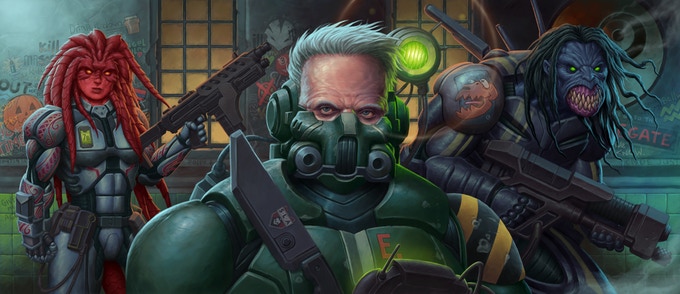
What have been your key influences when developing SLA Industries?
Firstly, I was driven by SLA itself. As a teenager I lived and breathed the game, playing it a few times a week, every week for a couple of years. Now, twenty years later, to be a huge part of the IP is a real honour.
Rereading all that original material after many years really fired me up. Those years of playing SLA were an influence in themselves as well. Despite it being many years ago, some of my most memorable RPG moments and stories came from playing SLA with various groups and I’ve been able to draw from those experiences and feelings with the writing.
Outside of the game, I’m inspired by other RPGSs, as well as lots of cinema and literature. I am a huge fan of the cyberpunk genre. SLA has always had the curse that people lump it into that genre, despite the fact that there are no cybernetics or really any of the stuff that makes that genre what it is, other than the constant rainfall and densely populated urban landscape.
It would be a lie to say that that genre doesn’t inspire me though; I just de-cyber it all in my head. I guess the vibe, creativeness and dystopian aspects of that genre are good at inspiring me to write more.
I also read a lot of RPG books, of all genres. I’m inspired by good creative writing and, there’s some really great content being produced in this industry at the moment. I think any writer that works on RPGs (or anything else for that matter), who doesn’t bother to check out what other writers are producing, is doing themselves an injustice.
The metaplot to SLA Industries revealed in the writer’s bible was imaginative. Is this still canonical or has it been retconned?
It was imaginative, but it was also not fully developed or ready for public consumption. Once it was out there, parts of it were incorporated into the data packets that were released in PDF form over the last few years. This in itself was problematic as the stuff that came into play during The Dream data packet, and then evolved further in the recent Cannibal Sector 1 is becoming more forefront in the game and making reference to parts of that ‘truth’ while not really giving the full story.
For those who read that document, although I wouldn’t recommend it, they’ve been left for years wondering, “is the truth a truth, or a lie?”.
As such, the second edition retcons the content of that old document and will present what the meta plot of the game really looks like. Some concepts and aspects remain, but can finally be properly explored, whilst others have been dropped or changed.
We’ll be more forthcoming with the fact that there absolutely ‘is’ a meta plot behind SLA Industries, building on the seeds that were planted in Cannibal Sector 1 and explaining the truth behind The World of Progress over the coming publications. We sat down as a team for four days to nail down what this looks like, what the implications are and how it ties into the game setting. We are really excited to take this from a confusing old document that was shared around forums and chatrooms to being a part of the story for the game.
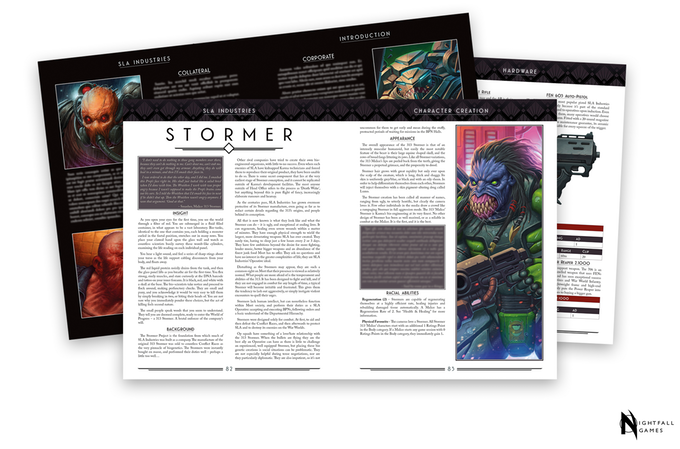
Has the advent of the internet, apps, and tablets affected the development of this new edition of SLA Industries?
It hasn’t influenced the setting. The World of Progress has the same technology level, but its certainly changed the way we work as a team. Email and Facebook messenger has allowed easy and constant communication between the Nightfall team, artists, proof-readers, play testers and fans.
Google Docs has made writing a breeze to share and edit as a team, and Google Sheets has done the same for schedules, writing and art allocation, as well as a range of other business-related functions.
From an art perspective, back in 1993, Dave was a pen on paper man, but the advent of artists tablets has meant he can work digitally, which in this industry is becoming a must. Jared is also a legend using Adobe and can do things with InDesign that I can’t even dream of, which has given us wider options in terms of layout and graphics etc. It is fair to say that technology has enhanced the way we work, but sometimes writing pen on paper still feels very ‘right’.
What is the current stage of development for SLA Industries and what do you have planned for the future?
The core book is in a good place. Most the writing allocated to me is finished and everyone else is well into their stuff. We’ve completed well over half of the writing for the core book and much of the GM screen insert as well. Artwork is progressing well; SLA has always had a high density of art and producing that much at a very high quality takes time.
The success of the Kickstarter means that we can outsource some to artists we know and love, rather than locking Dave in a room on his own for four months and forcing him to draw everything on his own. I think he’s happy about that.
We have a production plan for coming releases, some of which we’ll announce soon, but we need to meet and discuss a few things again before we make that announcement. A good way to look at it is that we chose to keep the page count on the core book to a tighter amount, using it to plant seeds for all the aspects of The World of Progress.
The book gives you everything you need to explore and play in the setting, with enough insight to all the major elements to excite and inspire, whilst allowing us to complete it in a timely manner. Those seeds need to grow, so we’ll be using the coming publications to expand the content you find in the core book, going deeper into the geography, the threats and the company.
What games do you play when not testing SLA Industries?
I play a lot of games at home with my kids and other half. We’re very much a gaming family and play something every day, whether it’s a full game of Scythe, or a quick game of Magic: The Gathering over breakfast.
The game I play the most is Android: Netrunner, as I organise a lot of local events and play the game competitively whenever possible. I have great love for that game and when I’m not thinking about SLA or other writing, I’m usually thinking about Netrunner.
I don’t really get to roleplay that much these days, though I am pretty deep into a The One Ring campaign with my kids. When I get to roleplay, I am almost always the GM and its usually SLA, In Nomine or Conspiracy X.
